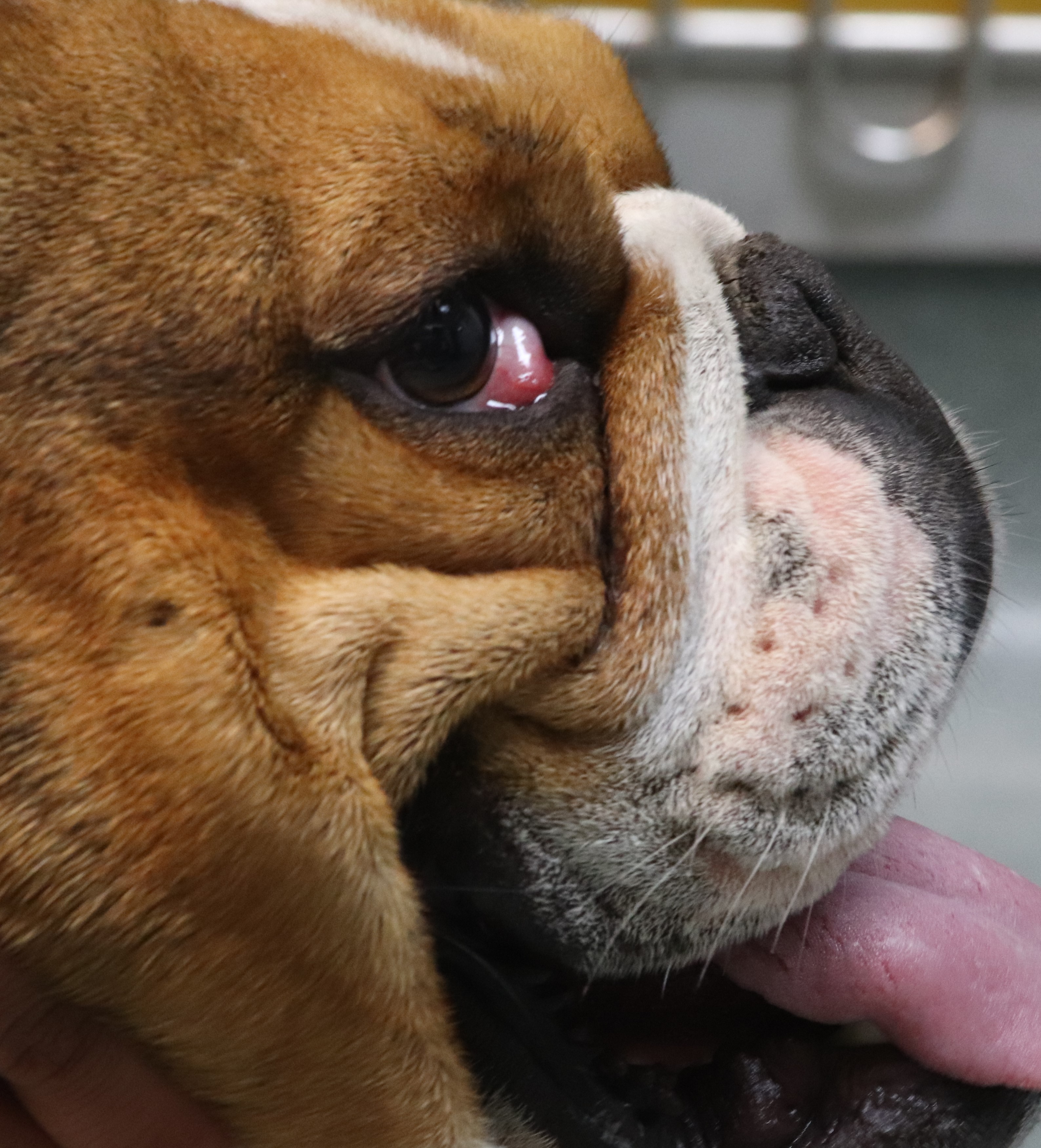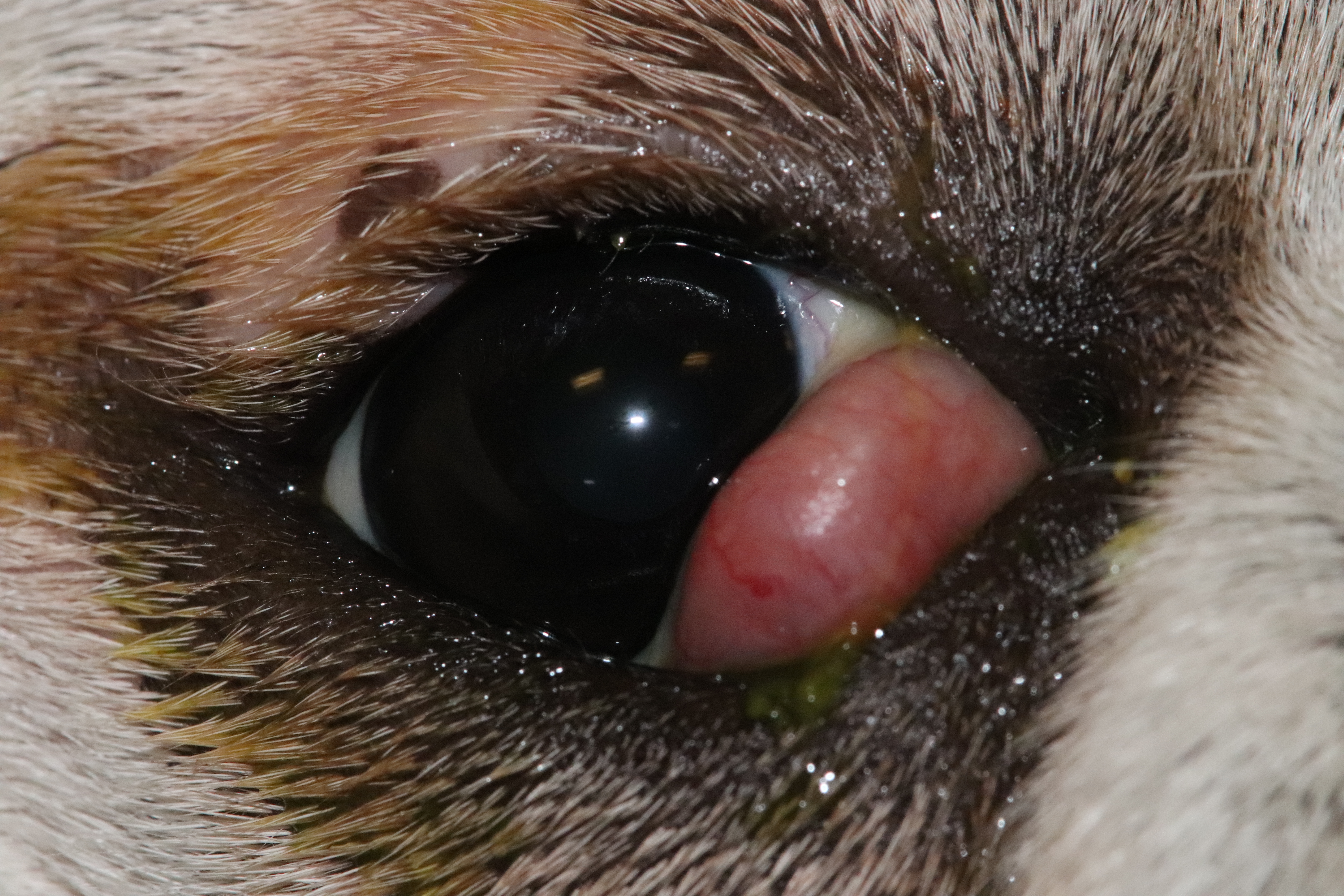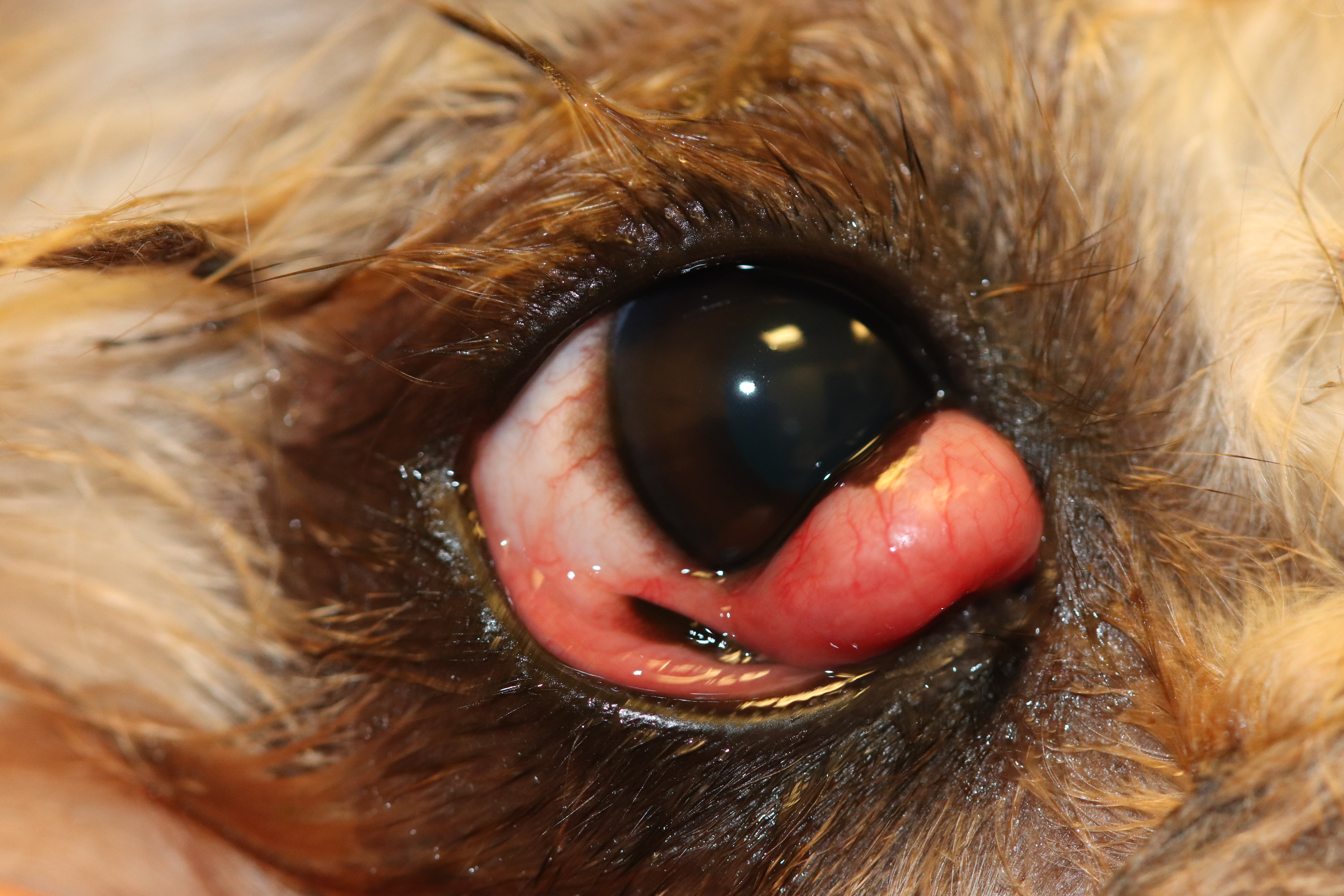New research unveils the extent of painful eye condition in dogs, and the breeds at most risk
Latest research from the RVC has revealed the true scale of cherry eye, a condition which results in the appearance of a large pink mass in the corner of a dog’s eye. The study also identified the breeds most at risk of developing the condition, including English Bulldogs and popular crossbreeds, such as the Puggle.

Taking its name from the pink mass that appears from the inner corner of the dog’s eye, the cherry eye condition clinically known as Prolapsed Nictitating Membrane Gland, is a result of the gland on the inner side of the third eyelid prolapsing, becoming red and swollen and covering part of the eye. If left untreated, the condition can cause discomfort and lead to complications such as dry eye, conjunctivitis and eye ulceration. Surgery is usually required to treat the condition and reposition the affected gland. The sudden appearance of this large mass protruding from their dog’s eye is very alarming to many owners.
Led by the RVC’s VetCompass Programme, the study was the largest exploration of cherry eye in dogs in the world. The research team followed the anonymised veterinary health records of 905,553 dogs for a year and identified that 0.20% (1,802 dogs) were affected by this condition. However, some breeds, and especially those that are flat-faced (brachycephalic), were at much higher risk.
Some breeds showed significantly high proportions of dogs affected with cherry eye each year: Neapolitan Mastiffs (4.9%), English Bulldogs (4.8%), Lhasa Apsos (1.6%) and American Cocker Spaniels (1.5%). Importantly, some popular designer breeds of flat-faced dogs were also hugely affected, such as the Puggle (Pug x Beagle) (2.1%) and Jug (Jack Russell Terrier x Pug) (1.2%), suggesting the recent craze for designer crossbreeds does not eliminate health issues associated with the parental pure breeds.
Additional key findings from the study include:
- One in every 500 dogs (0.20%) overall in the UK suffer from cherry eye every year
- The average age at first diagnosis of cherry eye was 0.6 years
- Brachycephalic (flat-faced) dogs had 6.9 times the risk of cherry eye compared with dogs with medium skull length
- Seventeen breeds showed increased risk of cherry eye compared with crossbred dogs. The breeds with the highest risk included Neapolitan Mastiff (x 34.3), English Bulldog (x 24.1), Lhasa Apso (x 12.4), American Cocker Spaniel (x 11.6), Puggle (x 9.5), Great Dane (x 6.2), Saint Bernard (x 5.3) and Jug (x 5.2)
- Sixteen breeds showed reduced risk of cherry eye compared with crossbred dogs. The breeds with the lowest risk included German Shepherd Dog (x 0.03), West Highland White Terrier (x 0.06), English Springer Spaniel (x 0.07), Labrador Retriever (x 0.12) and Lurcher (x 0.12)
- Purebred dogs had 1.4 times the risk of developing cherry eye compared with crossbred dogs
- Dogs aged under 1 year were at greatest risk of cherry eye (x 10.8) compared with dogs aged from 2 to under 4 years.
These findings provide valuable insight into the strong links between this important condition with specific breeds and can also help owners of high-risk breeds to identify the problem and seek appropriate veterinary care. Awareness of the link between the flat-faced (brachycephalic) skull shape of many breeds and the likelihood of these dogs developing cherry eye can also help the general public when deciding on which breed they should purchase.

Dr Dan O’Neill, Associate Professor in Companion Animal Epidemiology at the RVC and lead author of the paper, said:
“Given that humans designed dog breeds in the first place, we all carry a heavy responsibility to constantly improve our designs to breed away from poor health for these dogs. The hugely increased risks of cherry eye in popular flat-faced breeds such as English Bulldogs suggests that we have some way to go before we can consider many flat-faced breeds as designed for optimal health.”
“The findings from this study will hopefully help prospective owners make better informed choices when purchasing a dog. We urge all would-be dog owners to follow advice from the UK Brachycephalic Working Group to ‘stop and think before buying a flat-faced dog’.”

Dr Minna Mustikka, Senior Veterinary Ophthalmology Resident in training at the RVC Queen Mother Hospital for Animals and co-author of the paper, said:
“Cherry eye, if left untreated, may lead to other chronic eye problems, necessitating even lifelong medications and in worst case scenario, resulting in painful and potentially sight threatening complications. Raising awareness of this condition and it’s frequency in flat faced breeds is essential.”
Bill Lambert, Health, Welfare and Breeder Services Executive at The Kennel Club commented:
“This research, funded in part by The Kennel Club Charitable Trust VetCompass grant, helps us understand the prevalence of cherry eye in particular breeds. We hope to be able to use this evidence base to continue to work with each breed to identify areas of concern and closely collaborate to find steps that can be taken to improve the health of affected dogs. Using information and research in this way is invaluable in our work to make a difference to the lives of dogs and their owners.”
BVA President Justine Shotton, said:
“This important study offers strong evidence linking certain breed types with a higher predisposition to cherry eye. It is of particular interest to see a significant correlation between skull length and cherry eye, meaning that flat-faced breeds such as English Bulldogs are at increased risk of developing this condition. We hope the research helps better understand and address the health and welfare impacts resulting from brachycephaly.
“Anyone concerned about their dogs’ eye health should always consult their vet for advice.”
Notes to Editors
Reference
O’Neill et al. (2021) “Breed and conformational predispositions for prolapsed nictitating membrane gland (PNMG) in dogs in the UK: A VetCompass study”, PLOS ONE
The full URL for the article when published will be: https://journals.plos.org/plosone/article?id=10.1371/journal.pone.0260538
The DOI as a hyperlink will be: https://doi.org/10.1371/journal.pone.0260538
For media enquiries, please contact:
- Jasmin De Vivo jasmin.devivo@plmr.co.uk or rvc@plmr.co.uk
- Press Line: 0800 368 9520
About the Royal Veterinary College
- The Royal Veterinary College (RVC) is the UK's largest and longest established independent veterinary school and is a Member Institution of the University of London.
- It is one of the few veterinary schools in the world that hold accreditations from the RCVS in the UK (with reciprocal recognition from the AVBC for Australasia, the VCI for Ireland and the SAVC for South Africa), the EAEVE in the EU, and the AVMA in the USA and Canada.
- The RVC is ranked as the top veterinary school in the world in line with the QS World University Rankings by subject, 2021.
- The RVC offers undergraduate and postgraduate programmes in veterinary medicine, veterinary nursing and biological sciences.
- In 2017, the RVC received a Gold award from the Teaching Excellence Framework (TEF) – the highest rating a university can receive.
- A research led institution with 79% of its research rated as internationally excellent or world class in the Research Excellence Framework 2014.
- The RVC provides animal owners and the veterinary profession with access to expert veterinary care and advice through its teaching hospitals and first opinion practices in London and Hertfordshire.


